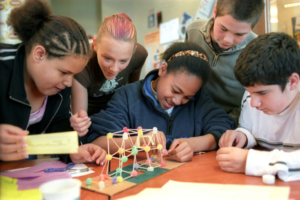Does Project-Based Learning Increase Student Learning? What Does Research Say?
Blog
The purpose of PBL is to develop what cognitive scientists call “usable knowledge.
This means knowledge that is not just recalled when needed for a test or an in-class response but rather, knowledge that once learned, can be used in daily life and in solving problems the individual encounters in the real world. This is the idea that learning is most effective when it involves knowledge learned by completing authentic tasks in familiar, everyday contexts (Lave & Wenger, 1991).
According to researchers, the conditions that motivate students to engage in PBL are also motivating to adults in their own lives. Researchers have identified four factors that contribute to job satisfaction for adults in the workplace.
Motivating jobs for adults: require workers to use a variety of skills rather than repetitiously applying a single skill; engages their interest from beginning to end; enables a person to experience a sense of completion and accomplishment; and finally, allows the individual to have an impact on other people or possibly even the world beyond the workplace (Hackman & Oldham, 1980).
There is forty years of accumulated evidence that the instructional strategies and procedures that make up standards-focused Project Based Learning are effective in building deep content understanding, raising academic achievement, and encouraging student motivation to learn.
 Studies comparing learning outcomes for students taught via project-based learning versus traditional instruction show that when implemented well, PBL increases long-term retention of content, helps students perform as well as or better than traditional learners in high-stakes tests, improves problem-solving and collaboration skills, and improves students’ attitudes towards learning (Strobel & van Barneveld, 2009;Â Walker & Leary, 2009). PBL can also provide an effective model for whole-school reform (National Clearinghouse for Comprehensive School Reform, 2004;Â Newmann & Wehlage, 1995).
Studies comparing learning outcomes for students taught via project-based learning versus traditional instruction show that when implemented well, PBL increases long-term retention of content, helps students perform as well as or better than traditional learners in high-stakes tests, improves problem-solving and collaboration skills, and improves students’ attitudes towards learning (Strobel & van Barneveld, 2009;Â Walker & Leary, 2009). PBL can also provide an effective model for whole-school reform (National Clearinghouse for Comprehensive School Reform, 2004;Â Newmann & Wehlage, 1995).
A 2015 literature review found that the design principles most commonly used in PBL align well with the goals of preparing students for deeper learning, higher-level thinking skills, and intra/interpersonal skills (Condliffe et al., 2015).
Research studies have demonstrated that PBL can:Â
- be more effective than traditional instruction in increasing academic achievement on annual state-administered assessment tests.
- be more effective than traditional instruction for teaching mathematics, economics, science, social science, clinical medical skills, and for careers in the allied health occupations and teaching.
- be more effective than traditional instruction for long-term retention, skill development and satisfaction of students and teachers.
- be more effective than traditional instruction for preparing students to integrate and explain concepts.
- improve students’ mastery of 21st-century skills.
- be especially effective with lower-achieving students.
- provide an effective model for whole-school reform and active student learning.

As with any teaching method, PBL can be used effectively or ineffectively. Â At its best, PBL can be the catalyst for an engaging learning experience and create a context for a powerful learning community focused on achievement, self-mastery, and contribution to the community. At its worst, when not properly developed or implemented, it can be a colossal waste of time for all concerned.
Researchers have identified several components that are critical to successful PBL (Barron & Darling-Hammond, 2008;Â Ertmer & Simons, 2005;Â Mergendoller & Thomas, 2005;Â Hung, 2008). While project-based learning has been criticized in the past for not being rigorous enough, the following features will greatly improve the chances of a project’s success:
- A realistic problem or project
- – aligns with students’ skills and interests
- – requires learning clearly defined content and skills (e.g. using rubrics, or exemplars from local professionals and students)
- Structured group work
- – groups of three to four students, with diverse skill levels and interdependent roles
- – team rewards
- – individual accountability, based on student growth
- Multi-faceted assessment
- – multiple opportunities for students to receive feedback and revise their work (e.g., benchmarks, reflective activities)
- – multiple learning outcomes (e.g., problem-solving, content, collaboration)
- – presentations that encourage participation and signal social value (e.g. exhibitions, portfolios, performances, reports)
- Participation in a professional learning network
- – collaborating and reflecting upon PBL experiences in the classroom with colleagues
- – courses in inquiry-based teaching methods
Teach & Kids Learn (TKL) offers teachers and schools several self-paced online courses to consider in helping to provide engaging and innovative project-based learning environments for students. Please review the following options for your next professional development opportunity.
